A review that’s a lot late to the game, but a new price makes this Bluetooth cable a contender.
We here at Headphonesty pride ourselves in delivering reviews of the hottest and newest headphones, IEMs, and all the related gear on the market. So why on earth are we reviewing a Bluetooth cable that was released almost 2 years ago?
Because it was priced at $200. Then it dropped to a better deal at $120. Now? Now the Shure RMCE-BT2 is $49 and a no-brainer.
- AAC and aptX codecs deliver high-quality sound.
- Very good construction.
- The pendant design is practical, lightweight, and comfortable.
- Memory wires in cables work well.
- The Bluetooth connection is stable with a good range.
- Decent battery life.
- Utilizes a micro USB connector for charging.
- MMCX only with no 2-pin adapters included.
- No companion application.
- No HDAC or LHDC codec support.
- Not water-resistant.
- Few published specifications.
Perhaps a little backstory is in order. I recently found myself in the scenario of being flush with a variety of IEMs, but all of the wired variety. And then, really for the first time, I tried out TWS earbuds and fell in love with the convenience. However, I did not fall in love with the sound.
But I wanted it all!
That led me on a search for a Bluetooth cable to pair with my existing collection of IEMs. I encountered a few unacceptable options, such as the KZ Bluetooth cable which wasn’t a success due to an elevated noise floor and audible hiss. After more research, I eventually came across the Shure RMCE-BT2.
Upon release, the RMCE-BT2 was universally heralded as an improvement over Shure’s original BT1 cable. It fixed many of the previous model’s shortcomings, including short battery life, poor codec support, and a buggy interface. But with a launch price of almost $200, the critics were pretty vocal. It was just too expensive.
What’s that they say? Time heals all wounds. I don’t know about all that, but Moore’s Law tells us that time often makes tech cheaper. And that’s certainly the case with the RMCE-BT2. It’s now listed on the Shure website for a paltry sum of $49.
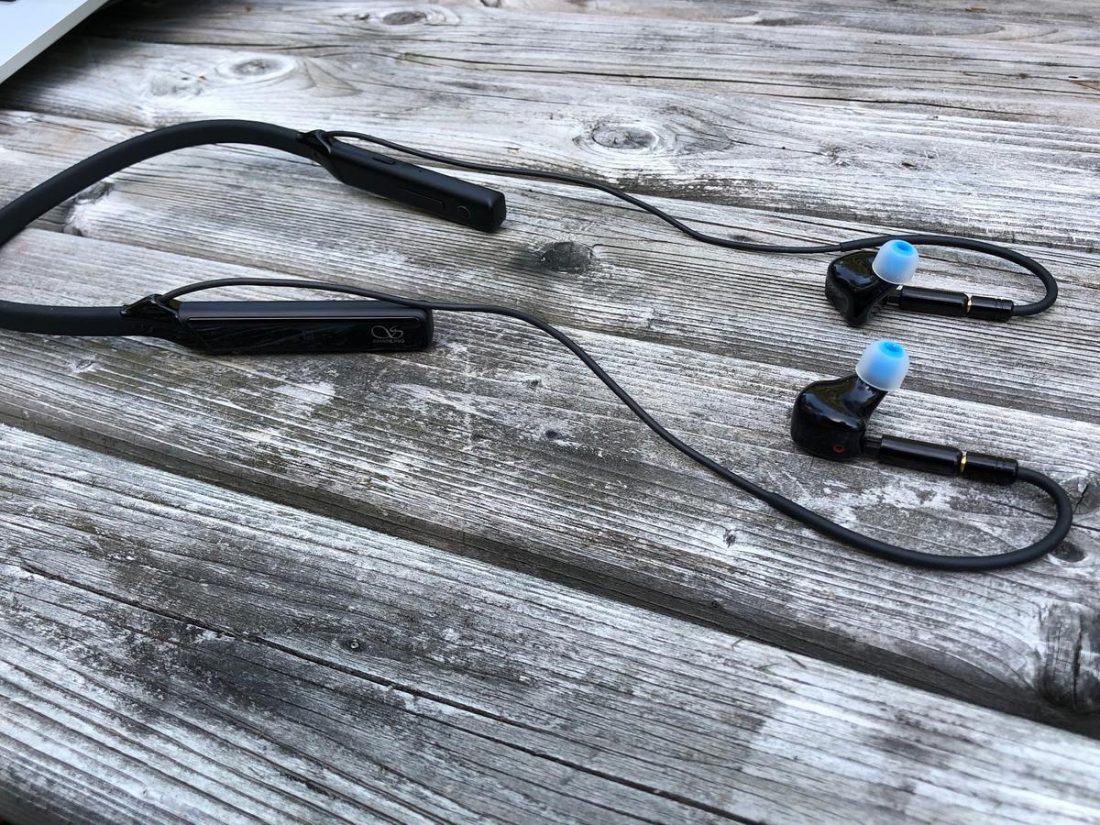
Now here’s the amazing thing. Even with all the current popularity of IEMs, there still aren’t that many decent Bluetooth cable options available. I just reviewed a particularly great new example, the Shanling MW200 Hi-Fi Bluetooth cable, which is a neckband style adapter, featuring an excellent build quality and all the latest tech.
Smaller sized wireless DAC/Amps with Bluetooth functionality (such as the soon to be reviewed xDuoo XP-2 Pro) have emerged to tackle the high fidelity portable wireless market, but they are certainly more ungainly than a cable from ear to ear.
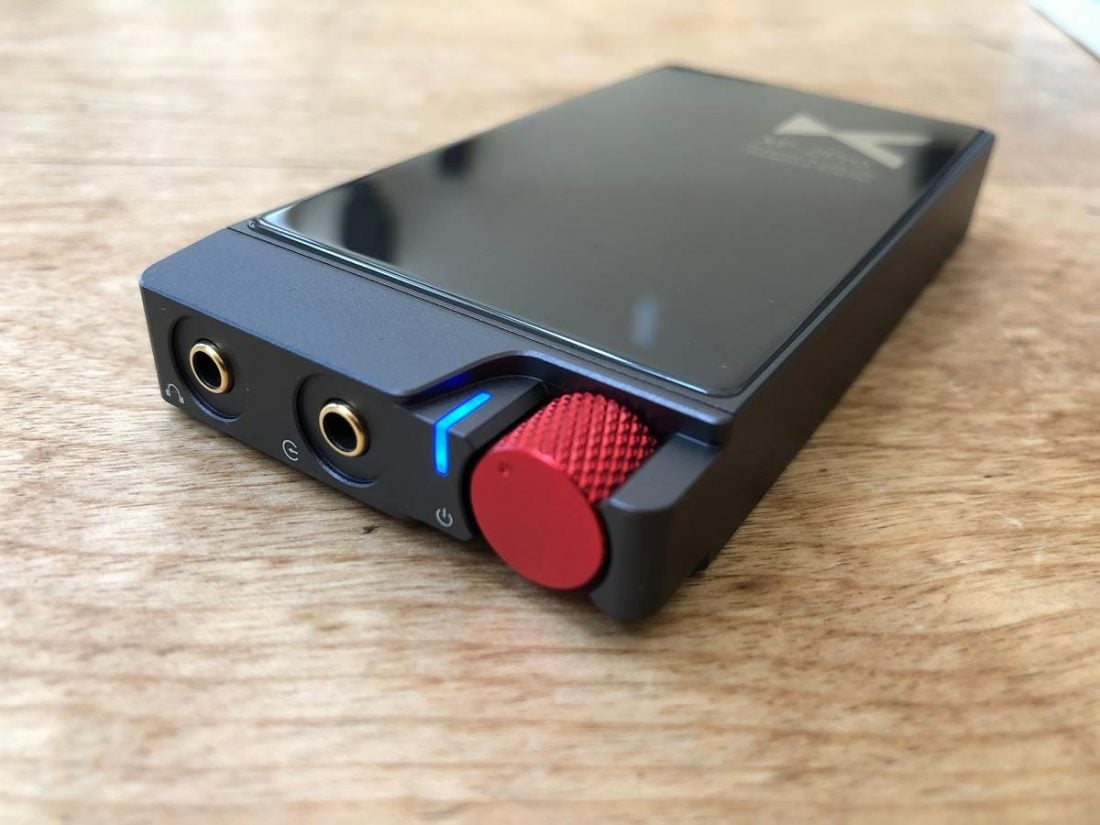
What becomes apparent when comparing the MW200 with the RMCE-BT2, is how little technology has changed over the last couple of years. Both feature MMCX connectors, a discrete DAC and amplifier, Bluetooth 5, high-quality Codex support, physical buttons, and (in the immortal words of Henry Ford) they are both available in any color you can want, as long as you only want black.
The MW200 does edge out the RMCE-BT2 with LDAC and LHDC codec support. However, now at less than half the price, the RMCE-BT2 makes a convincing argument that 2-year-old tech is still relevant.
Wireless headphones promise convenience, but that shouldn’t come at the expense of battery life, comfort, or sound quality. Let’s find out if the somewhat-long-in-the-tooth RMCE-BT2 can still deliver on its promises.
Shure Overview
Shure Incorporated is an American family-owned, audio product manufacturer. Shure was founded in Chicago, Illinois in 1925, by Sidney N. Shure. Originally a supplier of radio parts kits, they quickly found success with the manufacture of microphones. Over the last almost 100 years, in addition to the core business of microphones, they moved into producing turntable cartridges, mixers, headphones, IEMs, and other audio related products.
Shure is known for producing high-quality and reliable products, and state, “…we believe in working hard and doing things right. We don’t believe in short cuts… Our aim is to have the best products in our markets, and we strive to provide the very best service worldwide. These principles, conservative by some people’s standards, are precisely what has allowed Shure to remain an innovator and an industry leader.”
RMCE-BT2 Specifications
- Bluetooth Chip: Qualcomm ?
- Bluetooth version: Bluetooth 5.0
- Supported codec: aptX HD, aptX LL, aptX, AAC, SBC
- Audio DAC/Amp: ?
- Output power: ?
- SNR: ?
- Connectors: Industry-standard MMCX
- Water resistance: No
- Battery capacity: ? mAh
- Battery life: Up to 10 hours (SBC codec)
- Standby time: Up to 350 hours
- Charging: Micro USB port
- Weight: 14g
RMCE-BT2 Packaging
The small blue cardboard box that contains the RMCE-BT2 is entirely adequate, but nothing particularly special. The Bluetooth dongle is contained inside with an instruction manual and cable.
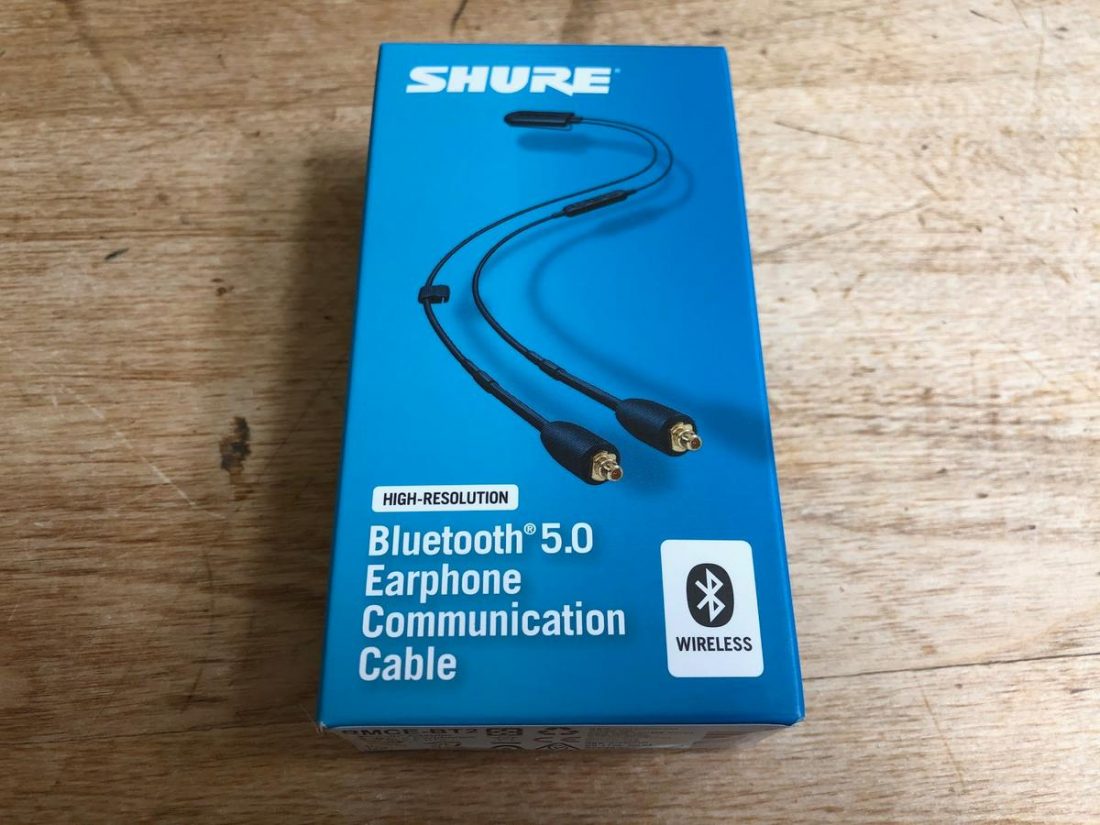
In the box
- RMCE-BT2 Bluetooth module
- Instruction Manual
- Micro-USB cable
Just like with the Shanling MW200, I lament the lack of MMCX to 2-pin adapters to make the RMCE-BT2 much more universally compatible. However, the lack of inclusion is more understandable with the Shure product, as they pointedly state that they don’t recommend swapping cables between Shure models, let alone using RMCE-BT2 with anything other than Shure SE IEMs (SE215, SE315, SE425, SE535, and SE846).
Cable
In practice, MMCX is a universal standard and of course, the RMCE-BT2 works fine with other IEMs with this connector. Yes, it may be possible that due to some odd design or implementation, they might not work. But in the vast majority of cases, it should fit.
Each 38 cm, black rubber-coated, flexible cable runs between the MMCX connector to the pendant that contains the battery, the Bluetooth module, and the charging port. The first 6 cm of each cable near the MMCX connector contains a flexible memory wire that holds its shape. This means that the cable can be formed into over-ear hooks, or whatever shape is most comfortable for the user.
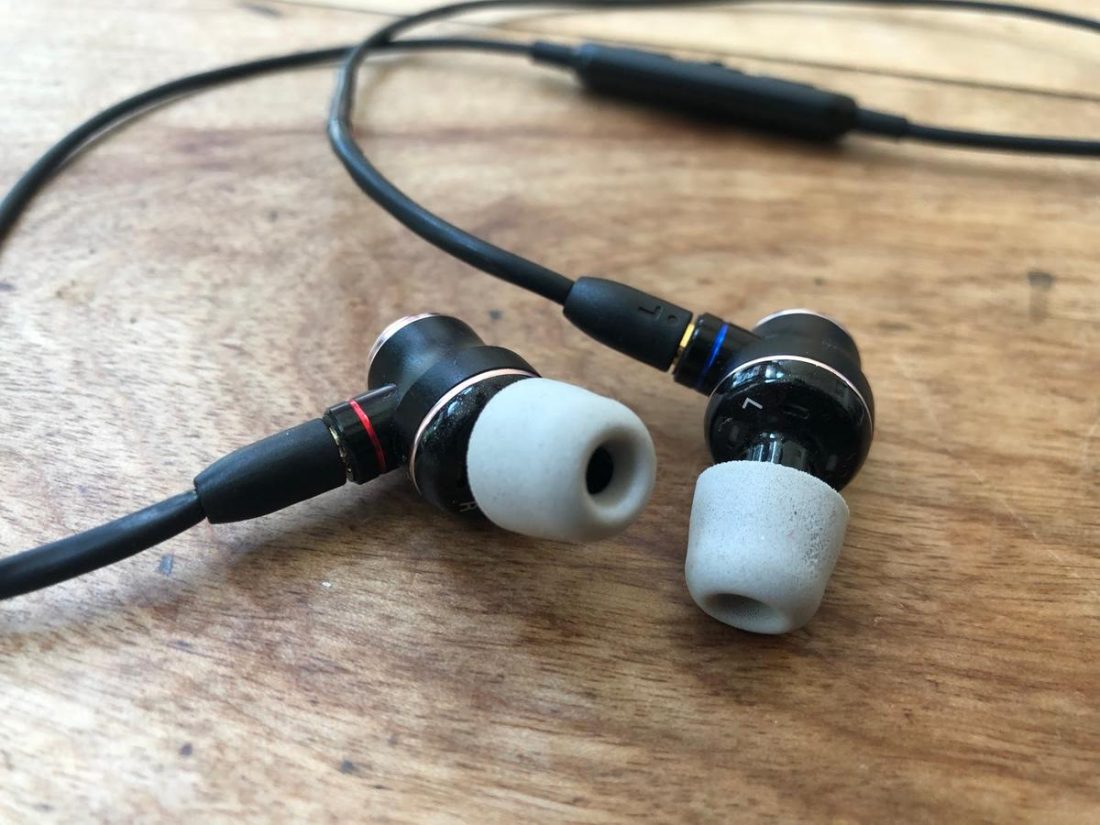
The inclusion of this memory wire solved one of the major issues I had with the Shanling MW200. Because the hook shape is permanent on the MW200 cables, I couldn’t use it with the JVC HA-FW01 IEMs. The JVC IEMs have bottom-mounted MMCX ports, and aren’t designed for over-ear wire routing. While the RMCE-BT2’s stiff memory wire isn’t ideal protruding straight downwards from the HA-FW01, it is workable.
There is a small cable management slider attached to the left side which can be adjusted until it hits the integrated mic and remote module on the right cable. The 3 buttons (Volume up, Power, Volume down) are nicely spaced and easily distinguished by touch.
To change a track, long-press the Volume up/down. Note that this is a difference from other Shure controls where you double-press the center button for next and triple-press for previous, so this may cause some confusion with long-time Shure owners.
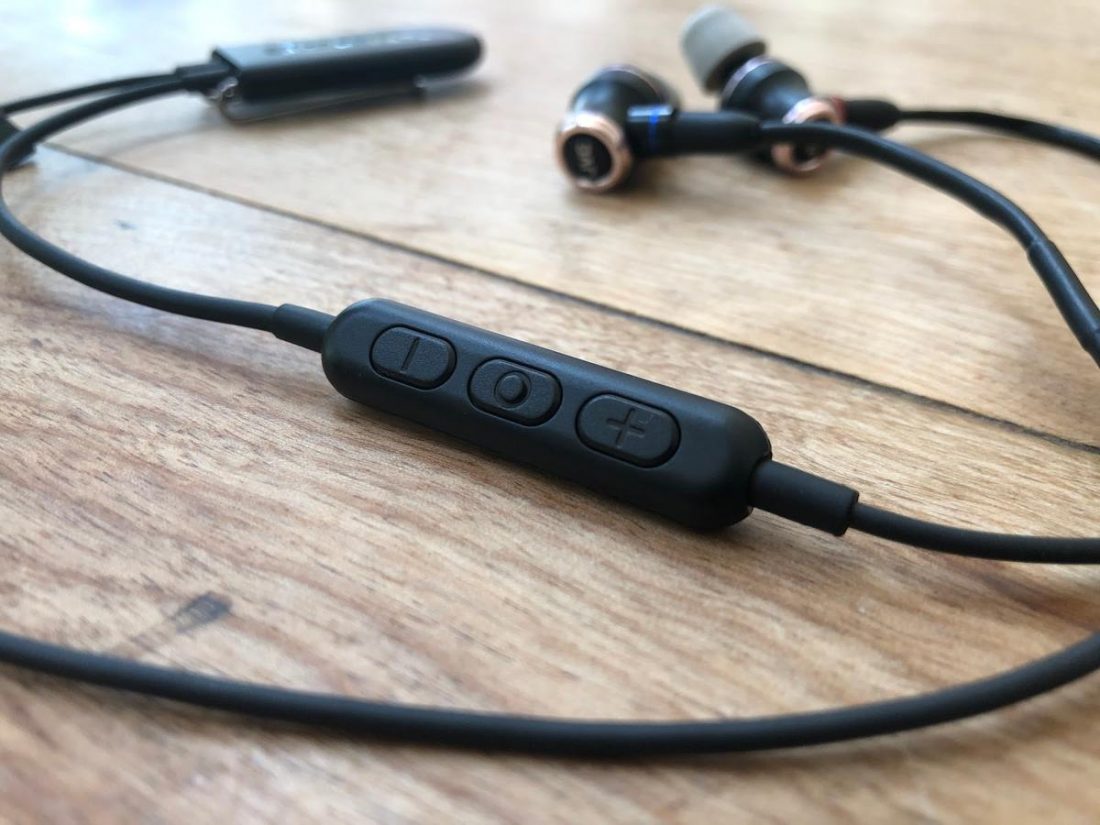
Unsurprisingly there is a tiny red/blue LED on the back of the microphone module that flashes blue when connected. Am I the only one who likes to use these things in a dark room or at bedtime? That flashing blue LED is enough to distractingly light up my surroundings.
The microphone works well with calls, but unwanted noise will be transferred if your clothes are rubbing on the cable.
RMCE-BT2 Design
The design of the RMCE-BT2 is fairly unique and likely decisive as a result. Reviews are mixed with some folks liking the pendant style, and others listing it as a con. The pendant itself is less than 2.5 cm by 5 cm in size and quite thin. It has a sturdy spring-steel clip on the textured plastic back. It’s clearly designed to be clipped to a shirt’s neck hole or collar.
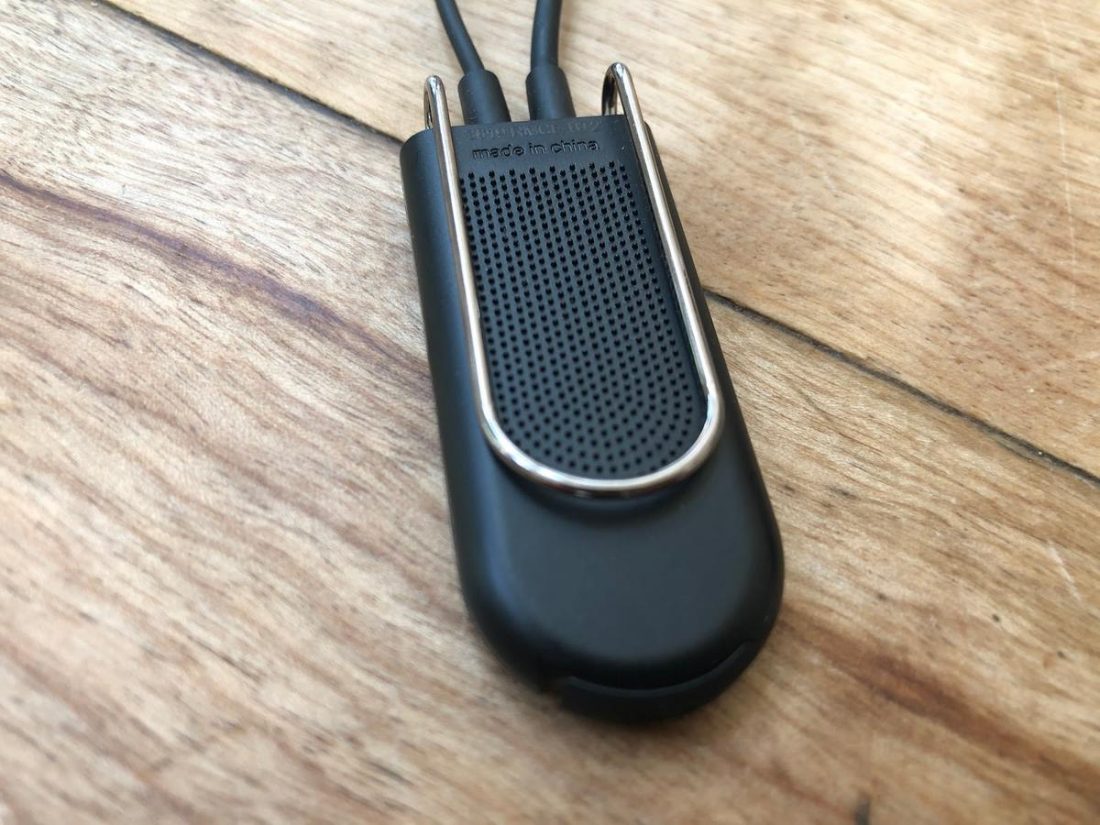
Used as intended, the small and light-weight pendant all but disappears when clipped to your clothes. It’s an alternative design to the neckband style of the Shanling MW200 and is much smaller and less obvious when you are wearing it. It works well. No complaints from me.
I also like the flexibility of being able to pull one IEM out of my ear and let it dangle within my shirt from the pendant. The cable is short enough to keep it fairly controlled, but I do worry about the potential for loss if the MMCX connector pops out.
Battery
Shure is rather non-forthcoming with technical details for the RMCE-BT2, so while we don’t know the mAh of the included battery, I can get 9-10 hours of life out of it. It does take several hours to recharge using the included micro-USB cable.
For some folks, anything without USB C is unacceptable these days, but for the rest of us, the micro USB cable worked fine.
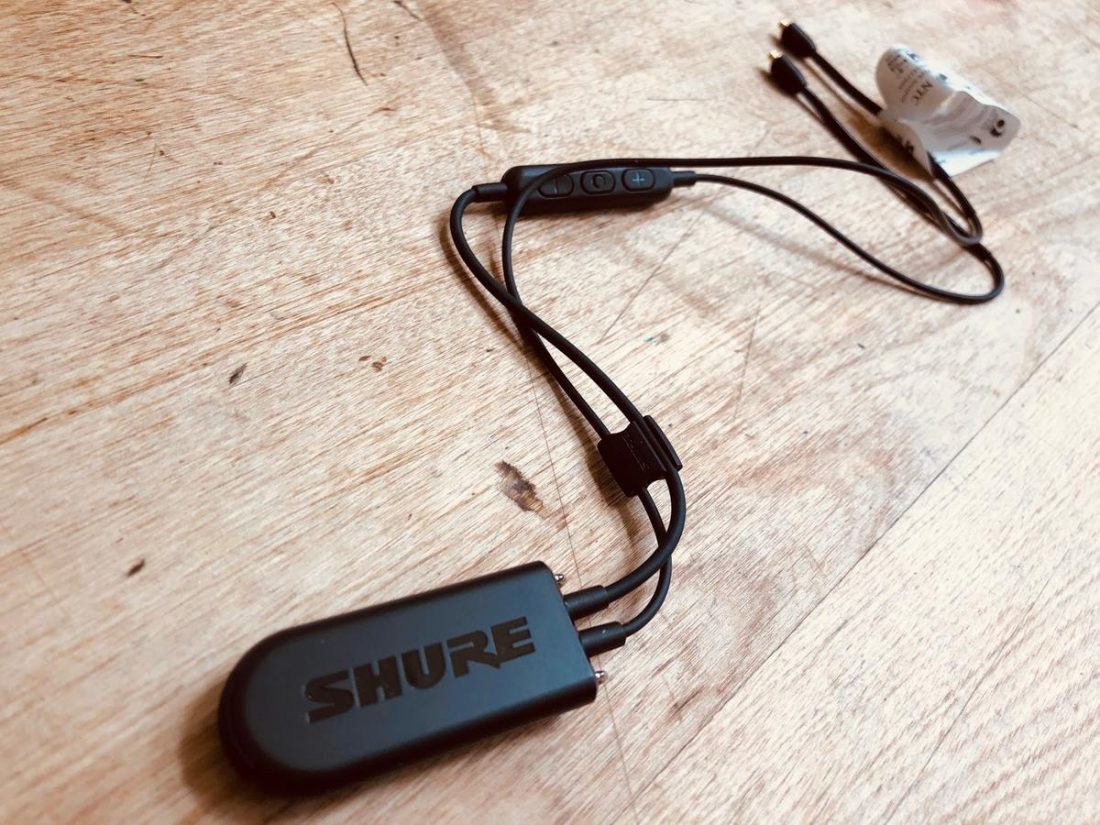
RMCE-BT2 Bluetooth
The Bluetooth connection is reliable and about what I expect from version 5. My pseudo-scientific test involves leaving my iPhone in the middle of the house and I wander to the not-so-far extremes. Dropouts only occurred when upstairs (behind walls) and at the far corners of the house. Same room usage was flawless.
Codec support
The RMCE-BT2 supports multiple codecs including Qualcomm aptX audio, aptX HD, aptX Low Latency (LL), AAC, and SBC.
AAC and aptX are virtually audibly indistinguishable, and both are an improvement over SBC. All Bluetooth codecs are inherently noisier than a wired connection, but this typically is only audible at high volumes (greater than 80 dB) and/or at high frequencies. As such, AAC, SBC, and aptX codecs roll-off sharply after about 16 kHz to minimize this issue.
While 16 kHz is still technically in the audible frequency spectrum, there is very little musical content at that extreme, and after about age 25 we usually lose the ability to hear frequencies that high.
Internal DAC/Amp
A big difference between the Shure RMCE-BT2 and other DAC/Amps you may encounter is the utter lack of transparency of what chipset is being utilized. Some theorize that the DAC/Amp chip was developed in house by Shure to tune the sound for their own earphones, but there is no proof that I have found one way or the other.
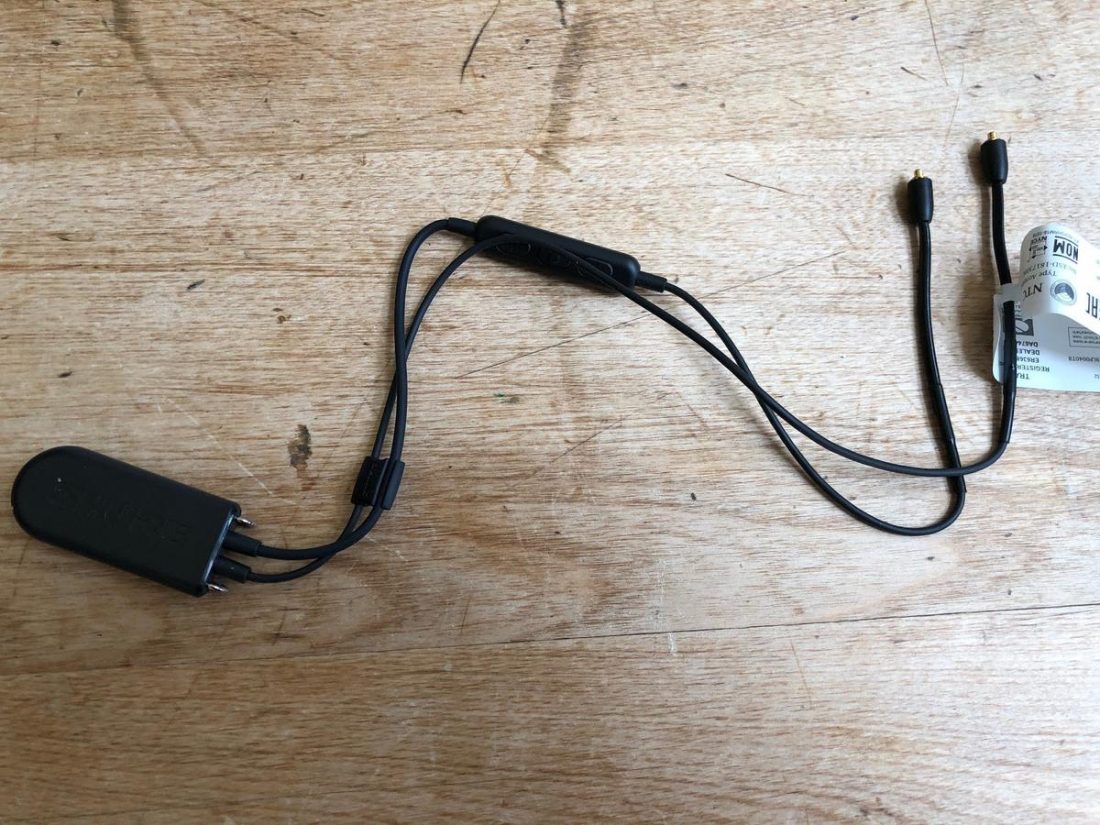
Certainly, lack of transparency precludes direct comparison with competitors like the Shanling MW200 which uses the new AKM AK4377A chipset. It also lets Shure marketing make sweeping statements like, “Premium, wireless audio performance. A dedicated, premium headphone amplifier provides superior, high-fidelity audio quality with wireless capability.”
Sure (Shure?), we’ll just have to take your word for it. No, wait… let’s give the RMCE-BT2 a listen!
RMCE-BT2 Sound
The noise floor on the RMCE-BT2 is very low. It’s undetectable in most situations at reasonable volume levels. As it should be, but so often isn’t with Bluetooth implementations.
The RMCE-BT2 has plenty of power to drive the JVC IEMs to loud levels. I came across some users complaining that there isn’t enough power on hand with the RMCE-BT2 to properly amplify their IEMs, but that isn’t what I experienced. Perhaps you may run into issues with particularly difficult to drive IEMs, but I’d expect that with any small Bluetooth adapter like this.
The little lady who lives in the dongle and tells you helpful things like “Power on. Connected. Battery more than 8 hours,” appears to have originated somewhere with an entirely neutral North American accent. Regardless, her voice is very clear and crisp sounding.
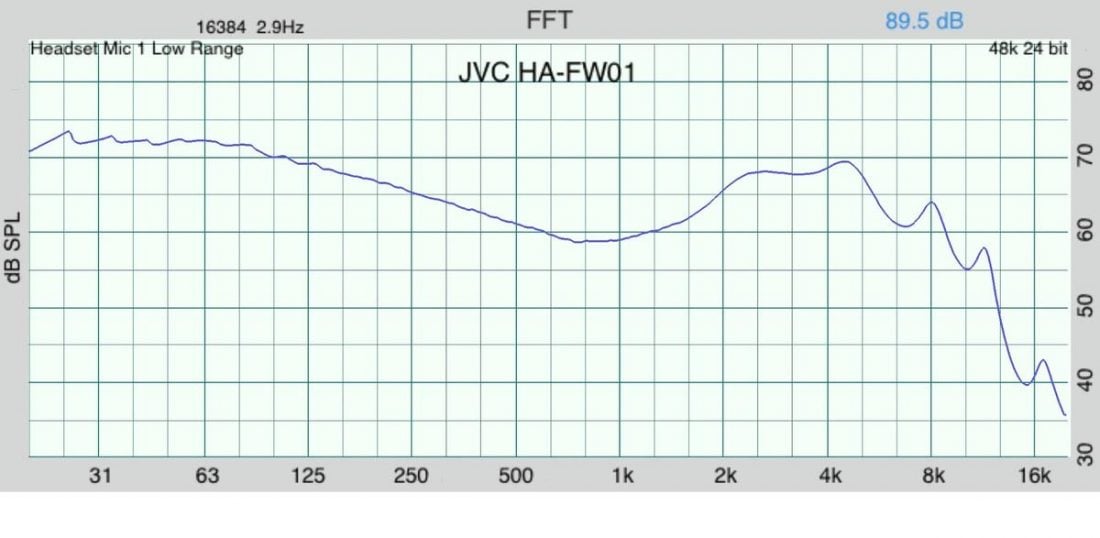
Much like the Shanling MW200, I find that listening with the Shure MRCE-BT2 was essentially the same as listening with a cable. Overall the sound quality is very good and free of any unwanted additions or detractions. The good and the bad elements of your MMCX IEMs will be delivered accurately.
Note the essentially identical measurement graphs with the JVC HA-FW01 IEMs both with their included cable and with the Shure RMCE-BT2 (via the AAC codec).
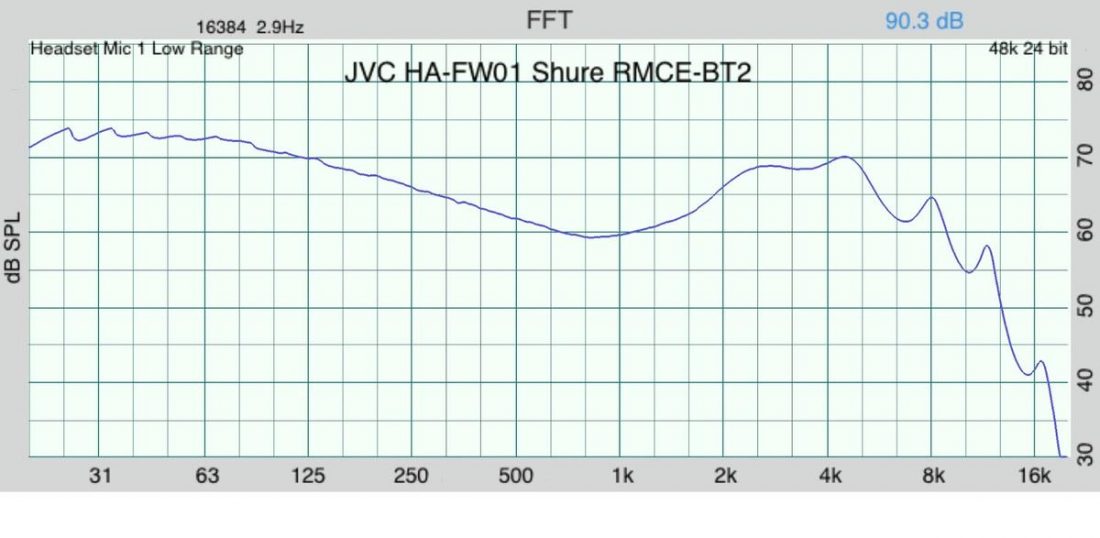
If you are in a silent environment and critically listening, by all means, you should change over to a wired connection to avoid any of the potential drawbacks of Bluetooth. But if you are on-the-go, or just listening for pleasure, the MRCE-BT2 should deliver all that you need.
RMCE-BT2 Comparisons
The two obvious comparisons to make are with the Shure RMCE-BT1 and the Shanling MW200.
The RMCE-BT2 improved upon the original BT1 in several ways including better codec support, Bluetooth 5.0 vs Bluetooth 4.1, and the inclusion of a dedicated headphone amplifier. Additionally, the battery run time of the RMCE-BT2 is improved to 10 hours, vs 8 hours.
| RMCE-BT2 | RMCE-BT1 | Shanling MW200 | |
|---|---|---|---|
| Range | 30 ft. (10 m) | 30 ft. (10 m) | 30 ft. (10 m) |
| Battery Life | Up to 10 hours | Up to 8 hours | Up to 14 hours |
| Connectivity | Wireless, Bluetooth 5.0 | Wireless, Bluetooth 4.1 | Wireless, Bluetooth 5.0 |
| Compatibility | MMCX | MMCX | MMCX |
| 3-Button Remote + Mic | Yes | Yes | Yes |
| Cable Length | 2x 28 cm | 127 cm | 2x 28.5 cm |
| Supported Codecs | Qualcomm aptX, aptX HD, aptX Low Latency, AAC, SBC | SBC | LDAC, HWA LHDC, aptX HD, aptX LL, aptX, AAC, SBC |
| Headphone Amplifier | Integrated | No | AKM AK4377A |
| Wearing Style | Shirt Clip | Removable Clip | Neckband |
| Companion Application | No | No | iOS, Android |
Better codecs equal better sound. Bluetooth 5 improves range and reliability. Dedicated DAC/Amp chips increase power and fidelity. Obviously the RMCE-BT2 is much closer to the Shanling MW200 than the BT1 in most of the ways that matter.
RMCE-BT2 Conclusion
I purchased the ‘Shure RMCE-BT2 High-Resolution Bluetooth 5 Earphone Communication Cable’ (such a catchy name!) from Amazon. And I’m not sorry I did.
The RMCE-BT2 is representative of Shure products at their best. It’s not flashy. It’s not the absolute cutting edge. It’s well-made, practical, and just works. Utilitarian but also quite expensive.
The good news is, now it’s an absolute bargain.
The RMCE-BT2 is a great introduction to the world of Bluetooth if you’ve got a pair of MMCX IEMs.
That’s it. I’m going to take a lesson from Shure’s practical approach and I’m not going to ramble on ad nauseum. Good working Bluetooth at a good price is… err… good!
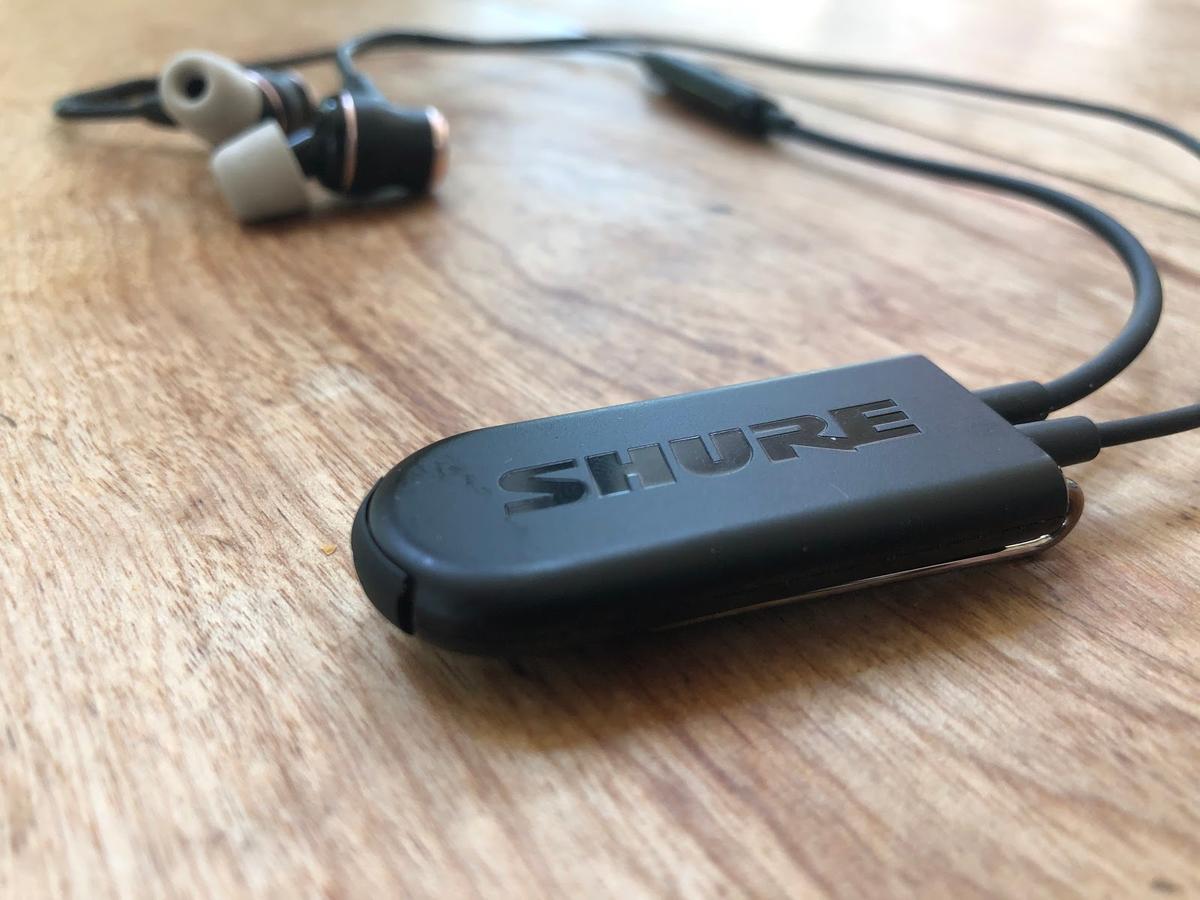
Thank you!
I have used many Shure BT1 cables with my SE215 iems over the last several years. They have been great, except for the reason I have used -many- is because they only last about a year for me. Fortunately, Shure has replaced the BT1 a couple times for free.
How many hours of use do you have on the BT2 cable?
Hi. I’m not sure of total hours. 100 more or less? The Shure does primary duty for a pair of modded Koss Porta Pros (I added MMCX connectors) and Audible. So far so good. Fingers crossed for longevity. What has gone wrong for you?
Again my experience has been with the BT1.
There have been multiple failure modes with the several units I have had:
-on at least one unit the bendable ear piece has cracked
-headset turns off for no apparent reason
-speaker connection has failed on one ear piece or another.
I just sent in my most recent cable for service due to shutting down.
I keep replacing them because I really like my SE215 iems and want to stick with mmcx cables. I stick with mmcx cables because I have also had several headset cables break over the years.
I may be a little hard on my equipment because I cycle commute with one ear piece in while I am riding.
Two questions I’d love seeing answered:
1. Does it support Bluetooth Multipoint?
2. Do you know of a way to spot a fake if bought off Ebay? Ebay seems to be the only way to get one of these here in Germany right now.
Multipoint? Yes. It took over my wife’s connection to her wireless Porta Pros just last night when I powered it on and connected it simultaneously to my phone.
Fakes? I honestly don’t know. Check the box carefully. I bought from Amazon.